Drinking Water Protection
- Drinking Water Protection Home
- About Us
- A-Z Index of Contaminants in Water
- Community Public Water Supply
- Drinking Water Grants and Loans
- Drinking Water Institute
- Drinking Water in Schools and Child Cares
- Drinking Water Revolving Fund
- Laws and Rules
- Noncommunity Public Water Supply
- Source Water Protection
- Water Operator and Certification Training
- Drinking Water Protection Contacts
Related Topics
- Annual Reports
- Drinking Water Risk Communication Toolkit
- Drinking Water Protection External Resources
- Fact Sheets
- Forms
- Invisible Heroes Videos: Minnesota's Drinking Water Providers
- Noncom Notes Newsletter
- Sample Collection Procedures (videos, pictures, written instructions)
- Waterline Newsletter
Related Sites
- 10 States Standards
- Clean Water Fund
- Health Risk Assessment – Guidance Values and Standards for Water
- Minnesota Well Index
- Water and Health
- Wells and Borings
Environmental Health Division
Rushford Responds to Flash Flood that Submerges City and Knocks Out Utilities
From the Summer 2008 Waterline
Quarterly Newsletter of the Minnesota Department of Health Public Water Supply Unit, Waterline
A complete list of feature stories can be found on the Waterline webpage.
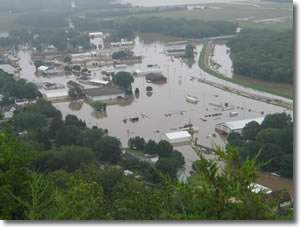 "I thought I knew everything about water and wastewater,” said Jeff Copley, water and wastewater supervisor for the city of Rushford, “until the flood came.”
"I thought I knew everything about water and wastewater,” said Jeff Copley, water and wastewater supervisor for the city of Rushford, “until the flood came.”
On the evening of Saturday, August 18, 2007, torrential rains began in southeastern Minnesota. In the early hours of Sunday, Rushford, a community of 1,700 people, filled up with water. Emergency vehicles drove through the city with the sirens sounding, using loudspeakers to inform residents to evacuate.
A dike protects Rushford from the Root River, described as “the traditional enemy of the city” by Rushford city administrator Winthro “Windy” Block. But it was Rush Creek, usually a quiet trout stream running into the Root River, that erupted. As more than 17½ inches of rain fell in the area, over five feet of water built up within Rushford, creating what Block called “a bathtub effect, water threatening from the outside and also the inside.”
The wastewater plant, as well as Rushford’s two primary sources of drinking water, wells 3 and 4, were flooded and shut down. Power and communication were out as more than 50 percent of the city was inundated.
Although many cities in the area had been hard hit by the flood, Rushford was the only one to have a public water supply knocked out of service.
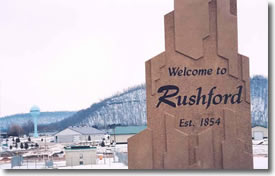 |
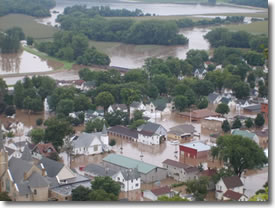 |
|
The city of Rushford was inundated by a flash flood last August as more than 17 inches of rain fell on parts of southeastern Minnesota. Rushford’s Jeff Copley, Dave Lombard, Doug Rislove, and Dave Howe worked long hours to restore water service to the city and were helped by volunteers from neighboring communities as well as Minnesota Rural Water Association (MRWA) and the Minnesota Department of Health (MDH). Below right, MDH engineer Mark Sweers checks on the status of leaking service lines that were being shut off in an attempt to restore pressure to the system. |
|
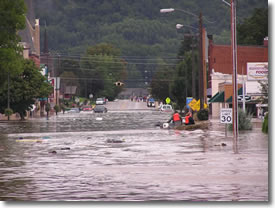 |
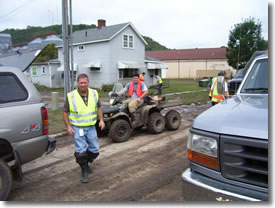 |
Recovery
Help from the outside came quickly. Jeff Dale of Minnesota Rural Water Association soon arrived, along with Minnesota Department of Health (MDH) engineer Mark Sweers, who came from Mankato. (The MDH engineer for southeast Minnesota, Paul Halvorson, was out of town at the time.) Hawkins Chemical Company and Minnesota Pipe & Equipment were among the companies donating labor and supplies. Utility workers from neighboring communities showed up with equipment and trucks. Four-wheelers were also used to get around town as all vehicles in Rushford had been submerged.
“Utilities was the place to start,” Block said of the recovery efforts. “The top of the dike system had water on both sides. Pumps were down and more rain was threatening to fall. Since we have a large agricultural community in the area, we benefited from the pumps and tractors [which were brought in], which helped the town to dry out.”
Sweers said the immediate goal for the water system was “to go from no pressure, dealing with line breaks, to get the system pressurized, at least for fire protection.” Well number 2, a backup well more than 50 years old, hadn’t been flooded and was put into service. “They shut off both reservoirs, the tower and ground-storage tank,” explained Dale. “There was little pressure, 8 psi [pounds per square inch], when they turned well 2 on. They shut off curb stops to people’s homes and started getting pressure back.” The system was fully pressurized after two days.
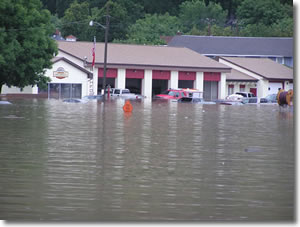 The city issued a notice to residents to not use the water for any reason for fear of losing well number 2. In addition, the wastewater plant wasn’t operating, leading to pressure from some city officials to turn well 2 off. Dale, saying they didn’t want to go back to negative pressure, resisted the suggestion and was backed by Sweers. The city soon allowed people to use the water but advised them to boil it before cooking or drinking until the water system was stable and samples showed no coliform bacteria in the distribution system.
The city issued a notice to residents to not use the water for any reason for fear of losing well number 2. In addition, the wastewater plant wasn’t operating, leading to pressure from some city officials to turn well 2 off. Dale, saying they didn’t want to go back to negative pressure, resisted the suggestion and was backed by Sweers. The city soon allowed people to use the water but advised them to boil it before cooking or drinking until the water system was stable and samples showed no coliform bacteria in the distribution system.
However, positive bacterial samples were continuing at wells 3 and 4. The city hoped to get them back on-line quickly to take the load off well 2, which had a broken check valve but couldn’t be repaired until another well was operational. The wells were disinfected and flushed more than 15 times, and Paul Halvorson got samples back to the MDH laboratory in Rochester, 50 miles away, as quickly as he could. However, the wells continued to have problems with bacteria. Eventually, well 3 was sealed and taken out of service. It wasn’t until the following March, nearly nine months after the flood, that well 4 was put back into service.
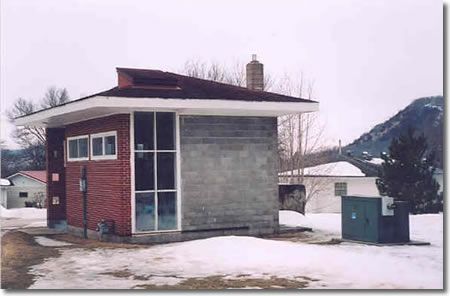 |
| Well number 2 kept Rushford supplied with water through the winter of 2007-08. |
Danny Nubbe and others from Mineral Service Plus of Green Isle, Minnesota, worked with Copley and the others on the wells. “After we worked on the problem of disinfecting wells and we were failing it,” said Nubbe of wells 3 and 4, “we started to wonder if there was something else than the flood water going down the well, a conduit or a channel for contamination. We weren’t getting anywhere.
“So we started going around looking for wells to see if we could find any open wells. Most of the houses in town that we found wells in were there before the water system [which started in the 1930s]. We found as many as four wells in one house, where people said they didn’t have any, but people welcomed us to come in and look.”
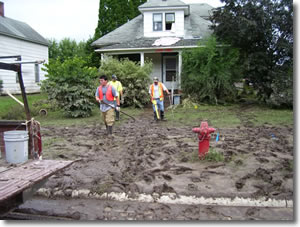 The crews discovered a variety of wells in the homes, mostly sand-point wells. Copley said they anticipated finding anywhere from 40 to 80 sand-point wells as they went from home to home. As of mid-March in 2008, they had found more than 300 and were still finding more. Some residents have never connected to the public water supply and still had operating wells in their homes. However, other wells had been abandoned. Some were capped but not sealed, and some weren’t sealed at all. Dale said the abandoned wells were “acting like a floor drain into the shallow aquifer used by some residents with operational private wells. We had to tell residents with operational wells not to use them, that the water could be contaminated.”
The crews discovered a variety of wells in the homes, mostly sand-point wells. Copley said they anticipated finding anywhere from 40 to 80 sand-point wells as they went from home to home. As of mid-March in 2008, they had found more than 300 and were still finding more. Some residents have never connected to the public water supply and still had operating wells in their homes. However, other wells had been abandoned. Some were capped but not sealed, and some weren’t sealed at all. Dale said the abandoned wells were “acting like a floor drain into the shallow aquifer used by some residents with operational private wells. We had to tell residents with operational wells not to use them, that the water could be contaminated.”
Nubbe and his crew began sealing the abandoned private wells (with costs covered by the county) and also set out in search for other wells in the city. “We investigated old records, talked to people—one guy in a rest home had a lot of good information. We started going through every record of the history of the town,” Nubbe said. “We went to museums to find out about industries in the town. We found there were wells drilled back in the 1800s that were 300 feet deep, so now we know there are large rock wells in the area.
“After finding information that the wells were there, we had to find out where the wells are. Some of the buildings are long gone. So with the help of the health department, we started getting old Sanborn insurance maps, started looking for landmarks, and started finding large wells.”
City well 1, long abandoned, eluded the crews for several weeks. Finally they determined it was beneath the Rushford State Bank. With permission from the bank, they chopped through the floor in the lobby. They didn’t find the well but did dig up an old water main. Following that, they finally located the well under the bank’s board room. The well, extending through the Ironton-Galesville, Eau Claire, and Mount Simon aquifers, was 580 feet deep and cased to 108 feet. It was full of rubble and other debris, including wood with creosote on it.
They dropped a camera down the well and could see the upflow coming from the Mount Simon and running into the Ironton-Galesville aquifer. “That helped open our eyes as to what was going in,” Nubbe said.
Another abandoned well, used by the railroad depot and going back to the 1800s, was found. “It was a dug well 14 feet across, pumping 450 gallons a minute,” said Nubbe. “The concern was that if a well will give 450 gallons a minute, it will take 450 gallons a minute, and the well was full of rubble. So we kept going through the town, locating wells, cleaning them out, sealing the wells, trying to eliminate all possibilities of contamination.”
Wells 3 and 4 continued to resist efforts to clean them up, and well 2 continued to supply the city’s water through the winter. Finally, in February, the decision was made to seal well 3. At this point, well 4 finally came up clean and was put back into service in March.
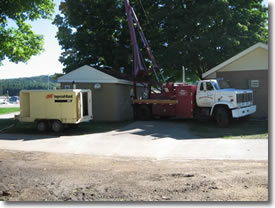 |
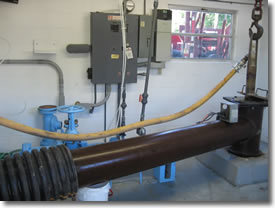 |
| Crews tried an air-lifting process to clean up well number 3. Despite repeated efforts, samples continued to detect coliform bacteria, and the well was finally sealed in February of 2008. | |
Minnesota WARN
The response to the flood was aided by the emerging Minnesota Water and Wastewater Agency Response Network (MnWARN). Although not yet formally activated, the mutual-aid network helped in organizing a timely response from other communities.
MnWARN is a mutual-aid agreement between utilities to help one another with personnel and other resources in the event of an emergency. In the past, police and fire departments and public-health agencies have had mutual-aid networks. A missing element has been utilities, which are now organizing. New Ulm water supervisor Al Lamm is a veteran of flood response. When he was with the Thief River Falls water department in 1997, Lamm coordinated response activities to the flooding in East Grand Forks. Lamm said it took him five days to organize that response. “With MnWARN,” Lamm said, “the response can be organized in a matter of hours.”
Since the flood, Rushford became one of the original partners in MnWARN, along with the cities of St. Peter, Hawley, and Elbow Lake.
Safety
While crews worked to restore the water system to protect the health and safety of the residents of Rushford, the safety of the workers themselves can easily be overlooked. Norm Hauschildt, the regional safety coordinator for Minnesota Municipal Utilities Association, was in Rushford to make sure the workers were looking out for themselves. “Mud is the least of your worries,” he said. “It’s the crap.” Hauschildt was referring to bacteria and other hazardous material that could be in the mud, dust, and water that crews were slogging through.
“Stay current on your shots [tetanus, hepatitis],” he advised. “If you’re sick, you’re of no value to anybody.” The American Red Cross was on site to administer shots. Hauschildt also said response crews have to be self-sufficient. Personal protective equipment, including high-visibility vests, portable ground-fault interrupters for generators and electronic equipment, and hand cleaners are important. “Think about washing your hands not just after, but before you go to the bathroom,” he said.
What’s Next?
“Barring any unforeseen hang-ups, the city is on its way to remedying its water woes with a $1,500,000 water treatment plant,” the Tri-County Record of Rushford reported August 10, 2007. The unforeseen hang-up of a flood came up a week-and-a-half later. As a result, the city has to move the site of the new plant and re-issue bids. Radium has been a problem for Rushford, particularly with well number 4. In addition, there have been aesthetic problems with the water because of iron and manganese. The new plant, along with the drilling of a new well, should solve the problems.
Beyond the new plant, the future of the city is uncertain. Copley notes that there have been many rumors as the Minnesota Department of Natural Resources investigates some of the factors in the flooding and the U. S. Army Corps of Engineers performs a study to see what actions may be taken. The rumors in Rushford involve the need to raise the dike, move residents a certain distance from the dike, or require people to purchase flood insurance.
“They may have to raise the dikes or even move the community to a different level of land,” said Block. “There is still the issue of a flood-plain designation to be determined.”
Meanwhile, the work goes on in Rushford. In March of 2008, Copley addressed a group of water operators in Rochester that included three members of his crew, Dave Lombard, Doug Rislove, and Dave Howe. “The fire department, ambulance service, police department did a wonderful job, and their jobs are done,” Copley said. “Ours is not. All of my guys are still going strong.”
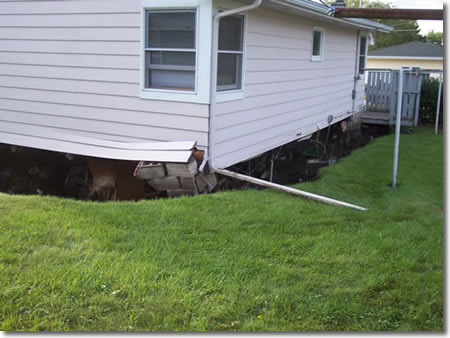 |
|
More than 50 percent of the homes and businesses in Rushford were damaged by the flood. Jeff Copley told water operators at the Southeast District Water School about the city’s experiences in recovering from the flood. |
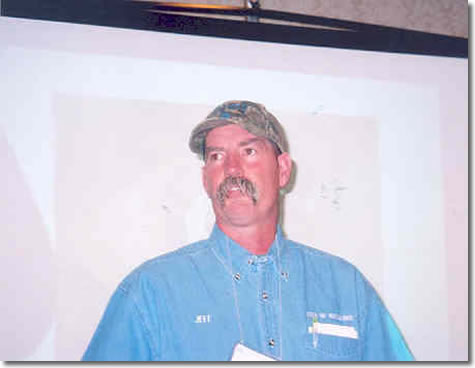 |
Go to > top.